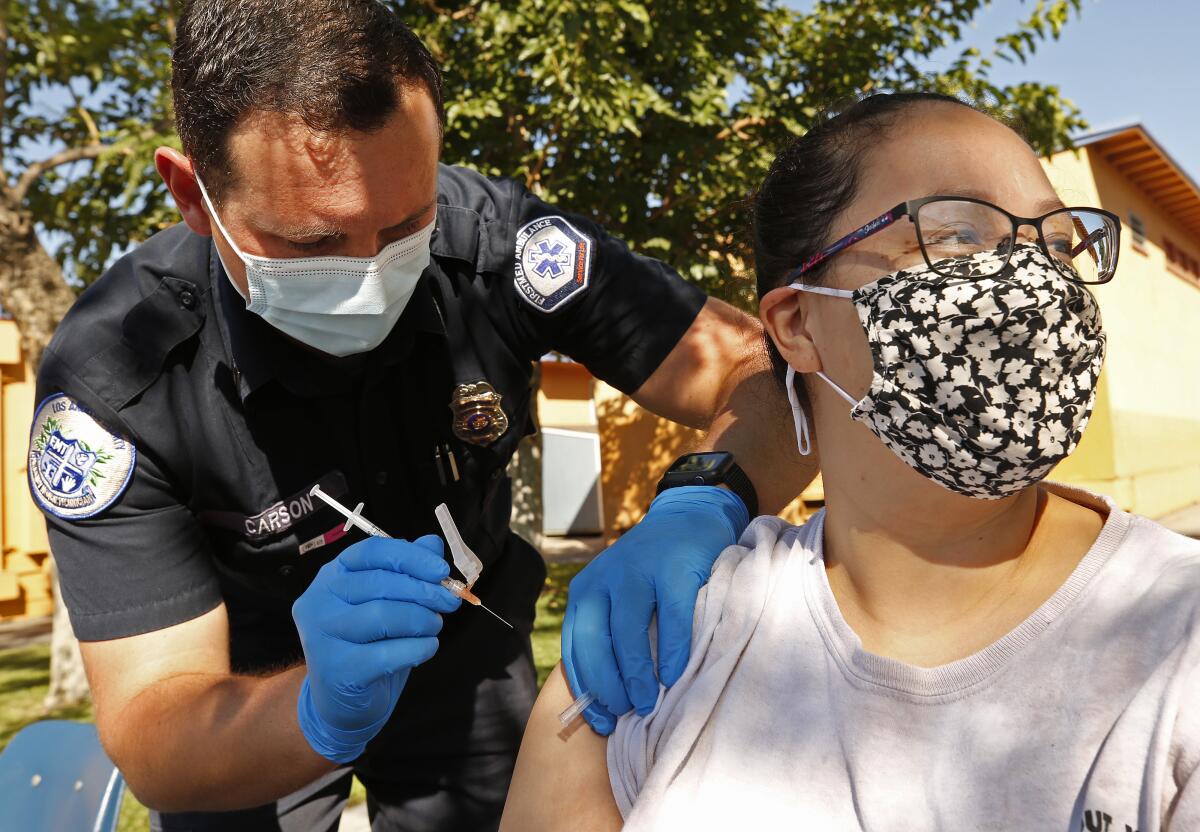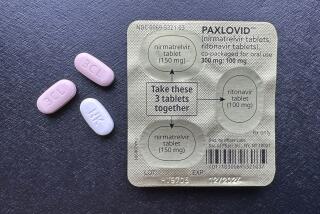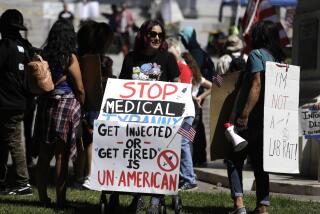Op-Ed: Refusing a COVID-19 booster shot won’t save lives abroad. Here’s why

- Share via
The call to give Americans a third dose of the mRNA COVID-19 vaccine has generated a vigorous and at times acrimonious debate among scientists, bioethicists and health policy experts. Many question the need for a booster shot at all; others highlight the potential vaccine inequities; some ask whether this action might thwart our ability to halt the pandemic.
For a path forward, we need to better understand the need for a third shot while also looking at the broader global landscape of what’s required to vaccinate the world.
First, the rationale for boosters. The White House COVID-19 Response Team informed the public that vaccine protection has waned over time, resulting in a significant number of breakthrough infections. Those vaccinated last winter with two doses of either the Pfizer-BioNTech or Moderna mRNA vaccines will be offered a third immunization. Ultimately, all Americans who received mRNA vaccines will need three shots to maintain protection, with another recommendation forthcoming for the Johnson & Johnson vaccine.
The evidence for waning immunity, possibly together with diminished effectiveness against the Delta variant, comes from studies in Israel (among the first adopters of the Pfizer vaccine). Those studies report a drop in COVID-19 vaccine protection by half — from more than 90% to around 40% to 50%. Studies from the U.S., including those from the Mayo Clinic and the New York State Health Department, also find diminished vaccine protection.
Less clear is the evidence that these declines also lead to significant breakthrough hospitalizations and deaths, but the White House has expressed concern that this is inevitable. In some states, 4% of hospitalizations are occurring among vaccinated patients. However, anecdotally, we are hearing from some hospital administrators and physicians who say they have seen vaccinated patients account for up to 20% of those hospitalized.
Many aspects of the booster recommendation make sense. When the two mRNA vaccines were rolled out in January, up to 3,000 Americans were dying each day. COVID-19 was then the leading cause of death on a daily basis. The two-dose schedule — spaced either three weeks (Pfizer) or four weeks (Moderna) apart — was intended to rapidly immunize Americans, especially vulnerable older populations in nursing homes and healthcare workers.
It worked, and many lives were saved.
However, that short interval has a downside — it is not optimal for maximizing immunity or ensuring long-term and durable protection. For example, most pediatric vaccines have at least an eight-week recommended interval between doses, followed by boosts at even longer intervals. Greater spacing helps to maximize immunological memory and antibody responses. For example, for the diphtheria-tetanus-pertussis (DTaP) vaccine given to infants, after three rapid immunizations, a fourth dose is recommended six to 12 months later, and a fifth three years after that.
There are similar spacing requirements for the Hib meningitis and inactivated polio vaccines, as well as the new Mosquirix malaria vaccine for Africa. It makes sense that the emergency COVID-19 two-dose rollout over the winter and spring now requires a follow-on booster months later. It’s possible that from the start, the mRNA COVID-19 vaccine was most effective as a three-dose vaccine, even without pressure from the Delta variant.
Before carrying out the three-shot policy, the supporting data must be reviewed by experts, including the Centers for Disease Control and Prevention’s Advisory Committee on Immunization Practices. There are many unanswered questions. What are the actual goals of a third immunization: to prevent hospitalizations or to prevent breakthrough infections as a means to halt virus transmission? What’s the evidence that a third immunization will achieve these goals? Is there a downside to a third dose, and could it increase the risk of myocarditis, an inflammation of the heart, among younger populations (which is very rare after two doses)?
Second is the critical issue of equity. There remain up to 90 million vaccine-eligible Americans who have not received a single dose of vaccine, mostly because of refusal or hesitancy. Closing these vaccine gaps remains a top priority.
Globally, things are far worse. Many African and Asian nations are overwhelmed trying to combat the Delta variant. They are desperate for doses of high-quality vaccines.
The pandemic must be addressed globally — both on humanitarian grounds and for our self-interest in preventing the emergence of other variants. But so far, the U.S. government has not moved fast enough on setting a strategy for vaccinating the world, besides making some modest donations of vaccine doses and loosening of patent restrictions.
At a minimum, for every booster shot for Americans, we need to commit to paying for and donating a dose of mRNA vaccine. This sends an important message that we are committed to global health and fairness.
But this alone is not nearly enough. If we are serious about getting ahead of the Delta variant, which is surging globally, we will need 4 billion to 5 billion doses of vaccine to immunize the world’s low- and middle-income countries by the end of 2021.
So far, this does not seem feasible with mRNA vaccines. As with any new technology, it takes time to learn how to produce these complex vaccines at the scale of several billion. This will eventually be possible, but it isn’t yet. That’s why we need to explore immunization with vaccines that can be produced at scale now. As a spokesman for the World Health Organization has said: “The world needs multiple vaccines that work in different populations.”
Texas Children’s Hospital Center for Vaccine Development at Baylor College of Medicine, for instance, has developed a low-cost recombinant protein vaccine technology for COVID-19, for transfer to vaccine producers in low- and middle-income countries. Biological E, one of India’s large vaccine manufacturers, plans to produce 100 million doses of vaccine per month using this technology. The Biden administration is funding some expansion of the manufacturing capability at Biological E, though more support is urgently needed. The Texas Children’s Hospital technology has also been licensed to BioFarma in Indonesia and to ImmunityBio — led by Dr. Patrick Soon-Shiong, the executive chairman of The Times — for South Africa and elsewhere.
The fact is, fully immunizing the American people with three doses of mRNA vaccine should not be equated to denying vaccine doses to the rest of the world. Rather than fighting over a limited supply of vaccine, we simply must produce more. This can be done. The costs are modest compared with the economic damage of an unending health crisis, and this is the surest way to end the pandemic.
Peter Hotez is a professor of pediatrics and molecular virology and microbiology and dean of the National School of Tropical Medicine at Baylor College of Medicine, where he is also co-director of the Texas Children’s Hospital Center for Vaccine Development. He is the author of “Preventing the Next Pandemic: Vaccine Diplomacy in a Time of Anti-Science.”
More to Read
A cure for the common opinion
Get thought-provoking perspectives with our weekly newsletter.
You may occasionally receive promotional content from the Los Angeles Times.










